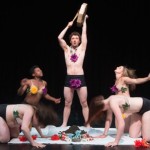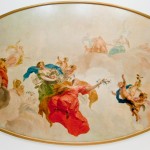I’ve now posted all eight of my family seasonal celebrations:
Myth: The Sun Child and Mother Night.
Activity: We released lanterns with New Year’s wishes on the longest night.
Lesson: In the darkest time of our lives, there is always hope.
Myth: Cerridwen’s Cauldron of Inspiration
Activity: We melted snow with candles and washed our hands in the water. We burned pieces of paper on which we had written things we wanted to transform.
Lesson: Change can bring positive transformation to our lives.
Spring Equinox (Lord & Lady Day)
Myth: The Return of Ishtar
Activity: We tied ribbons to garden tools (“charming the plow”) and planted seeds in seed pots.
Lesson: Life always returns.
Myth: Jesus and the Goddess (Magdala)
Activity: We danced around the Maypole with CUUPS.
Lesson: Both the God and Goddess are necessary.
Myth: The Sun Goddess and the Dark Child
Activity: We cut out shadow selves, decorated masks, and danced around the fire.
Lesson: We cannot ignore our dark side.
Myth: The Song of Songs (David and the Shulamite)
Activity: We ate ripe fruit and burned flower wreaths.
Lesson: Everything is always changing and best of things must eventually pass.
Myth: Isis, Osiris, and Set
Activity: We cut down a corn stalk and ate corn bread.
Lesson: Death is a necessary path of life.
Myth: The Wild Hunt
Activity: We were chased by the Wild Hunt.
Lesson: We have to let our wild side out every once in a while.
In a comment to the my last post on my family Summer Solstice celebration, Dver, a “spirit-worker on the margins of Hellenic polytheism” (who maintains the A Forest Door blog), observed correctly that my post had misstated the difference between chthonic deities and daimonic spirits. This comment raised a problem that I have when trying to communicate the Pagan mythos to my children. Paganism can be incredibly intricate. In simplifying it for my children, is something lost in the process?
I’ve written before about the four levels on which Neopagan ritual can be experienced.
1. Exoteric: Celebrates the changing of the seasons and connecting with the Earth.
2. Symbolic: Employs the changing of the seasons as an outward metaphor of inward personal changes, including the changes of the human life-cycle or the ebb and flow of enthusiasm that we experience psychologically.
3. Spiritual: Facilitates the process of individuation, by incarnating, consecrating, and integrating the daemonic/shadow elements of our psyche.
4. Mystical: Instead of the integration of the psyche, a (controlled) dis-integration of the psyche or sublimation of the ego.
The rituals I create for my kids falls into the first two levels, but hardly ever the third (consider the Summer Solstice ritual) and never the fourth.
I’ve been writing about ritual creation and ritual performance lately and it occurs to me that I need to draw a distinction here between my personal rituals and my family rituals. Ritual creation is difficult under any circumstances. Creating ritual for a group presents special challenges. Creating a ritual for a group that is mixed faith and only part-Pagan is especially challenging. Then add kids and the challenge can seem overwhelming. Then add the fact that one of the kids has ADD and the other is a bit of a flibbertigibbet, and try to make the ritual a mixture of reverence and revelry, didactic and transformative, and, well … it’s hard, to say the least.
The rituals I create for my family are not the rituals I would create for an adult group. They are not the rituals I would create for an all-Pagan group. (Just consider our May Day ritual which is a play about Jesus and the Goddess.) And they are not the kinds of rituals I would create for myself.
Having said that, I’ve been feeling for a while that I need to give my kids a taste of ritual that is less didactic and more, well, intuitive. I’m not talking about the third or fourth categories above. But maybe a little less talking about metaphors and a little more listening to the wind and touching the earth. How much exposition is necessary when teaching Paganism to children?
Ruby Sara was written that
“Ritual … is a space and time that is set aside in which the participant is radically engaged with all their senses, and is promoting Beauty, giving thanks, celebrating the Holy Body, aspiring towards Awareness, and creating/maintaining Sacred Relationship.”
That’s the kind of ritual that I want to introduce my children to.















